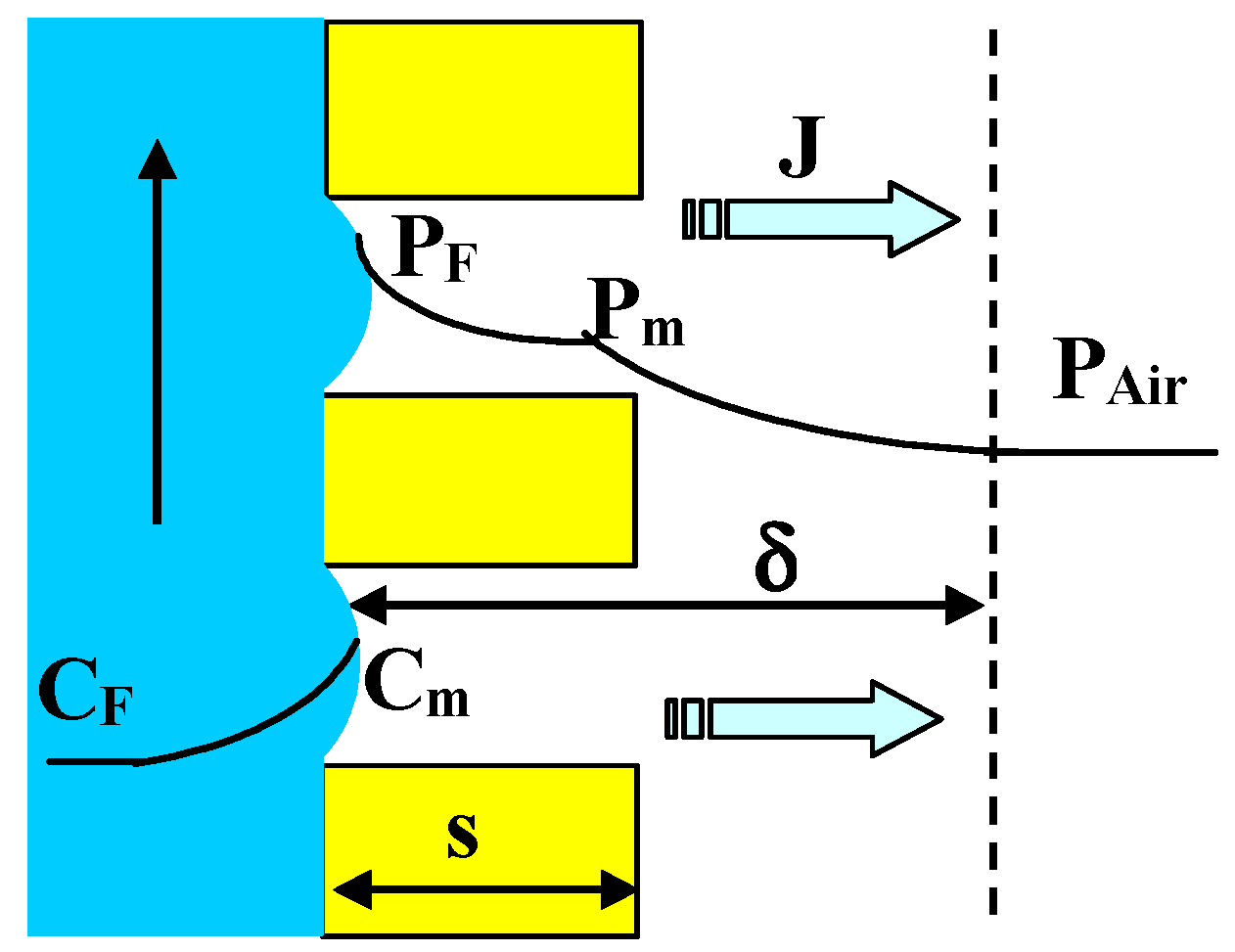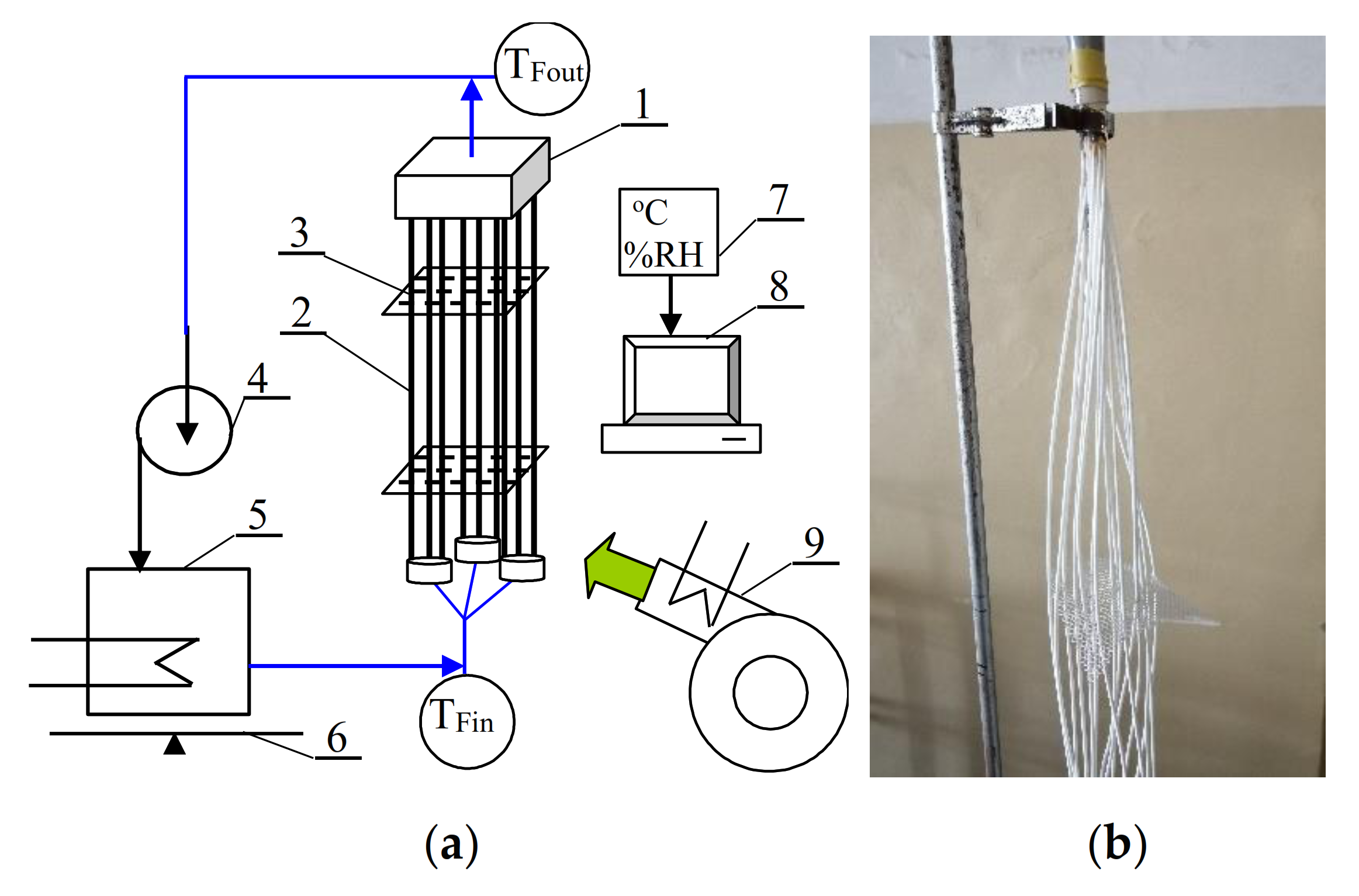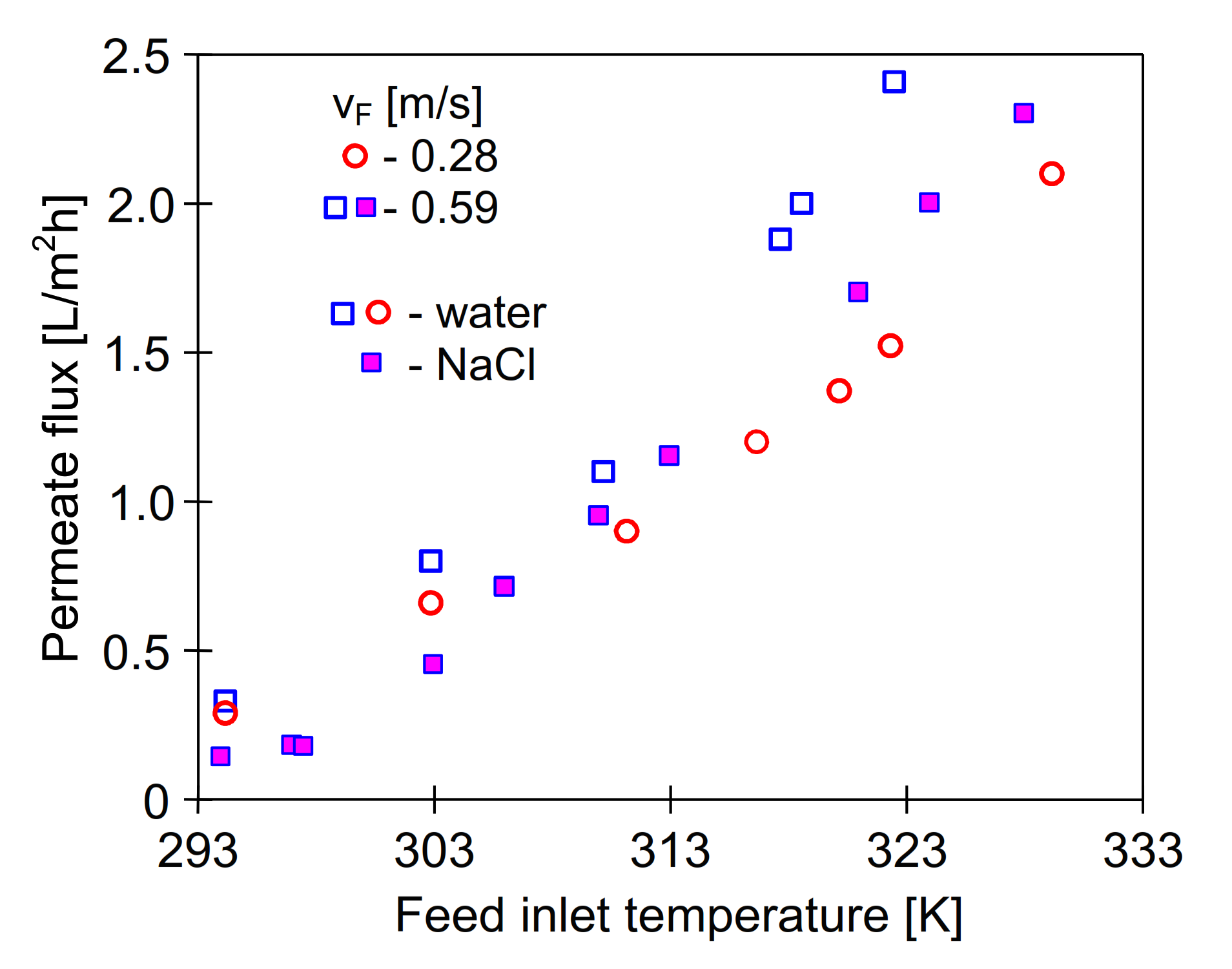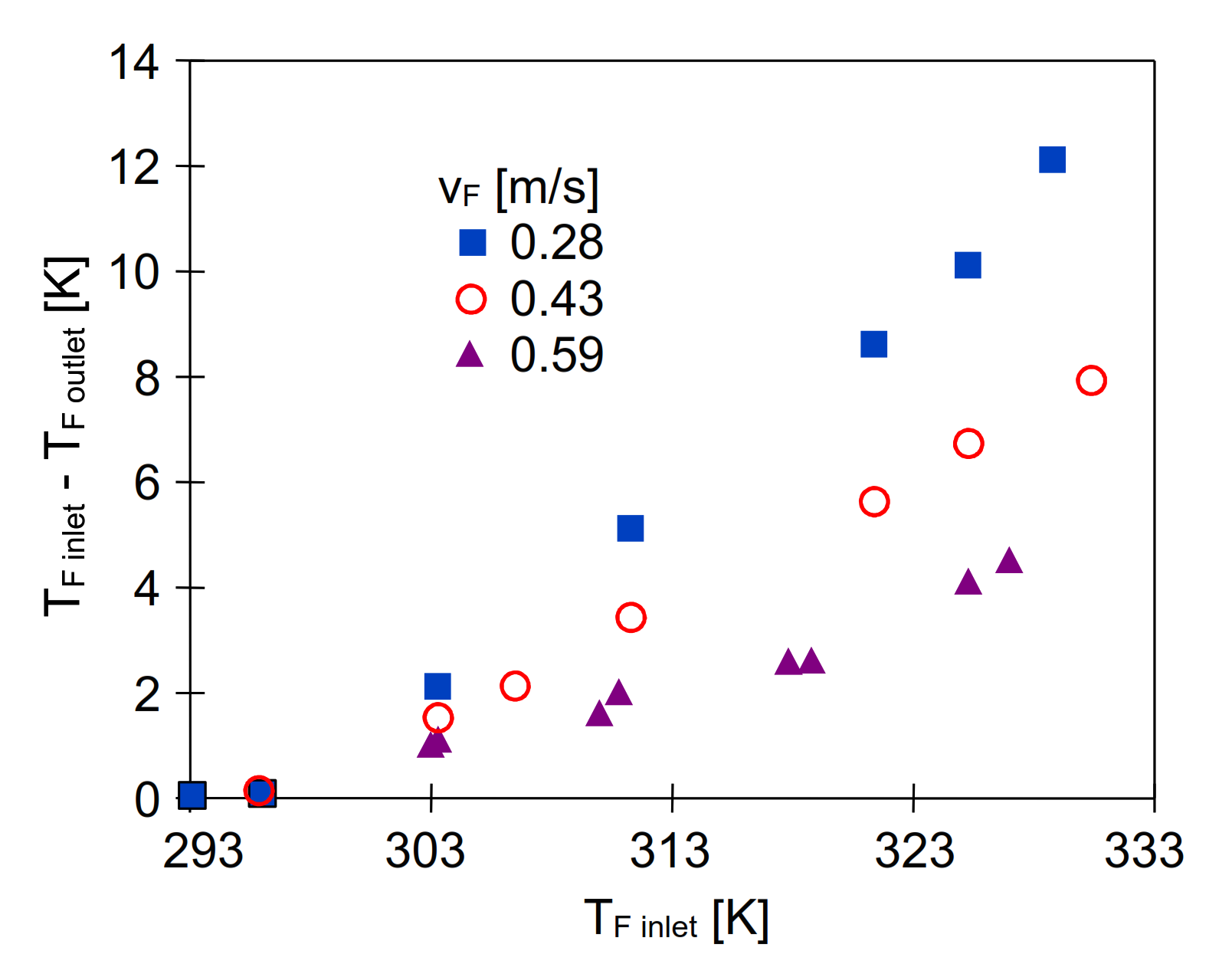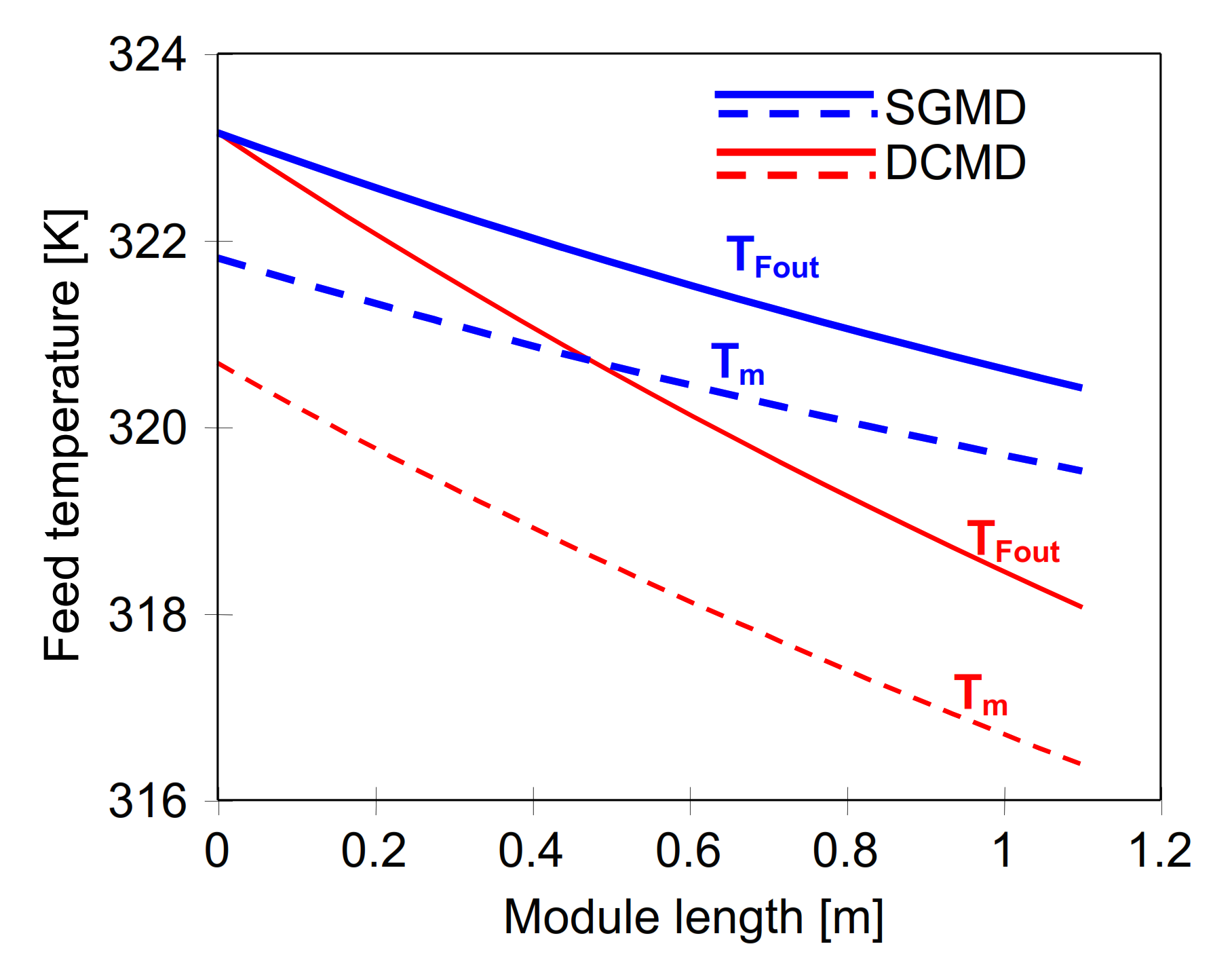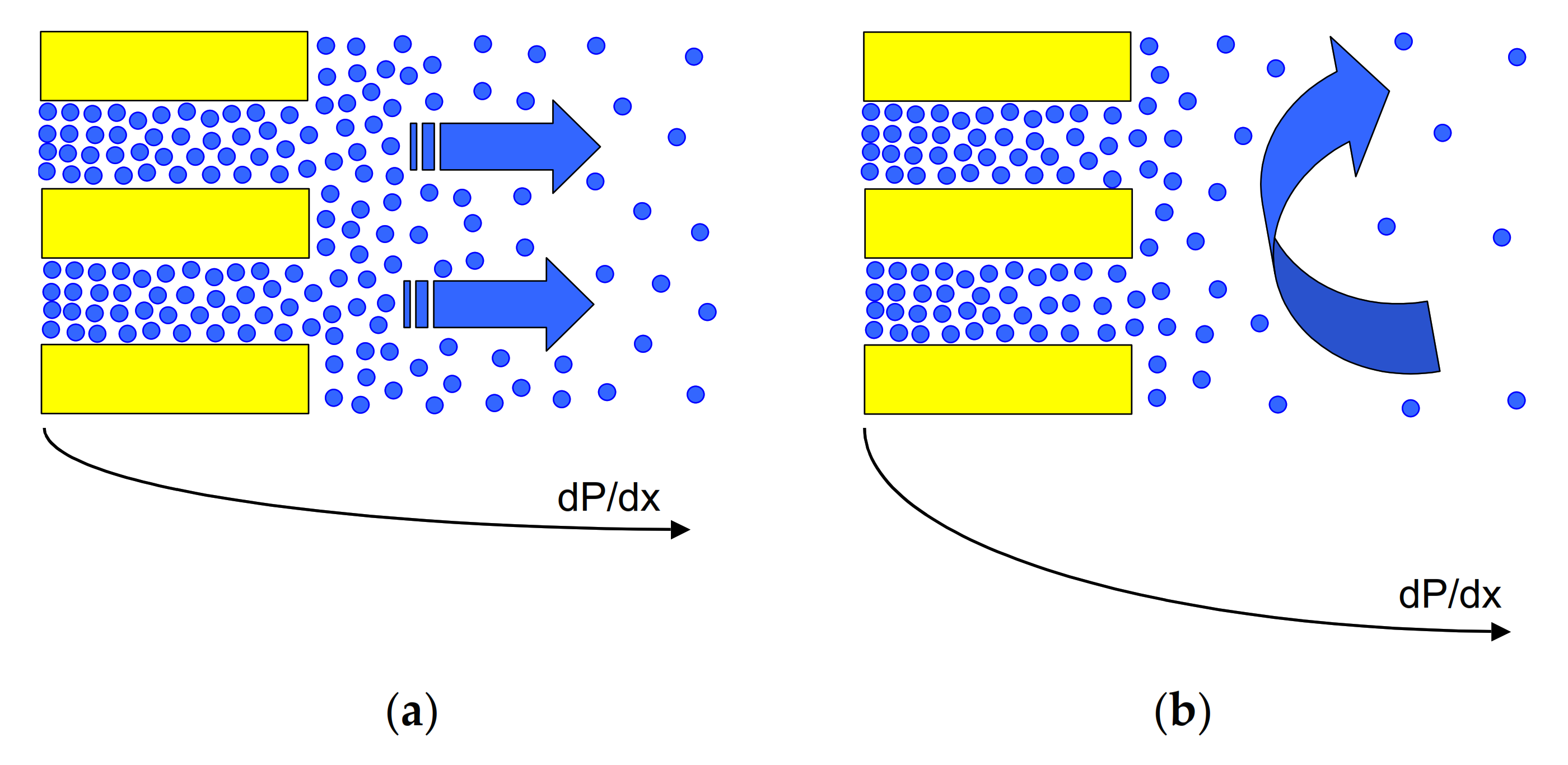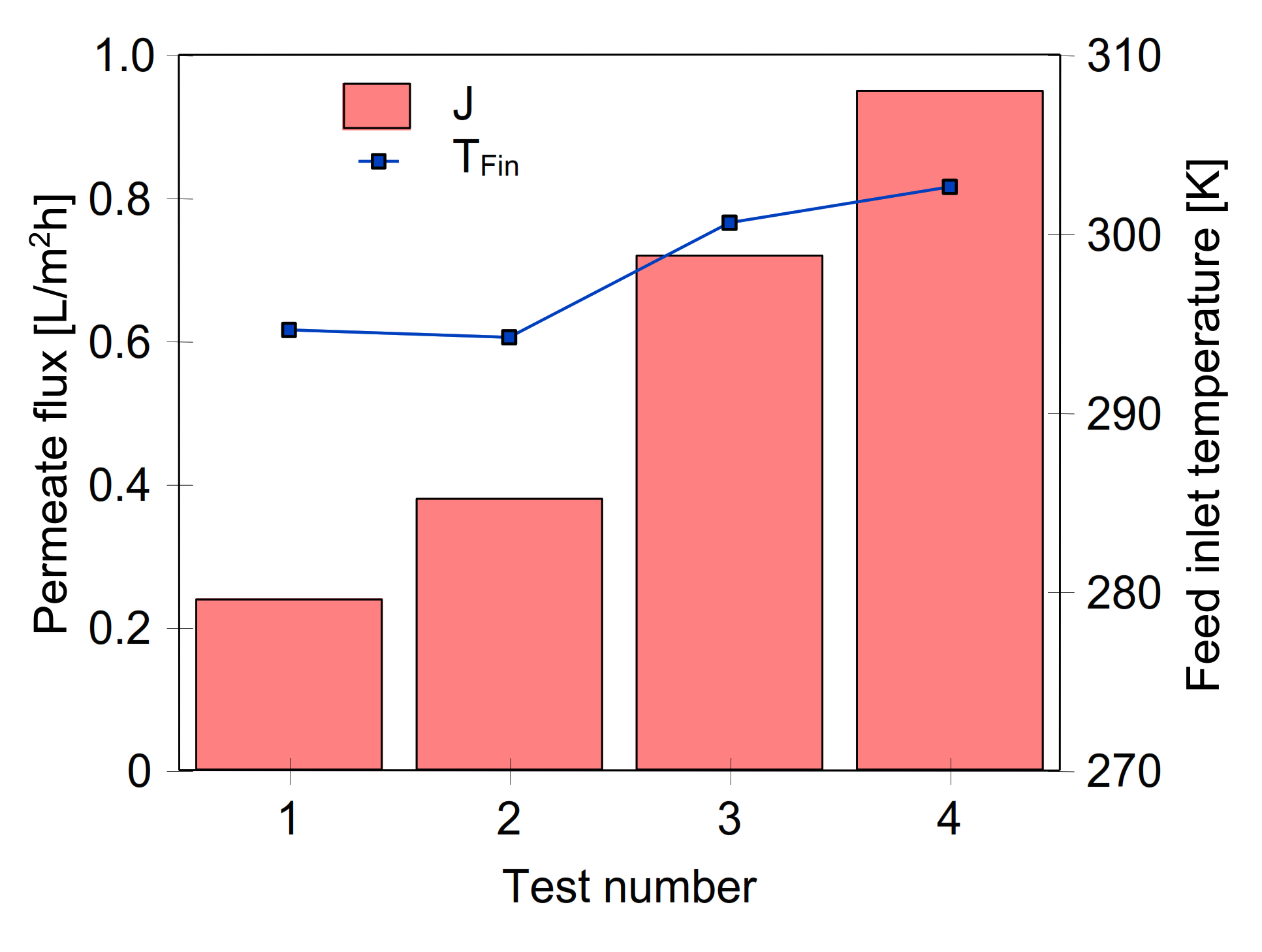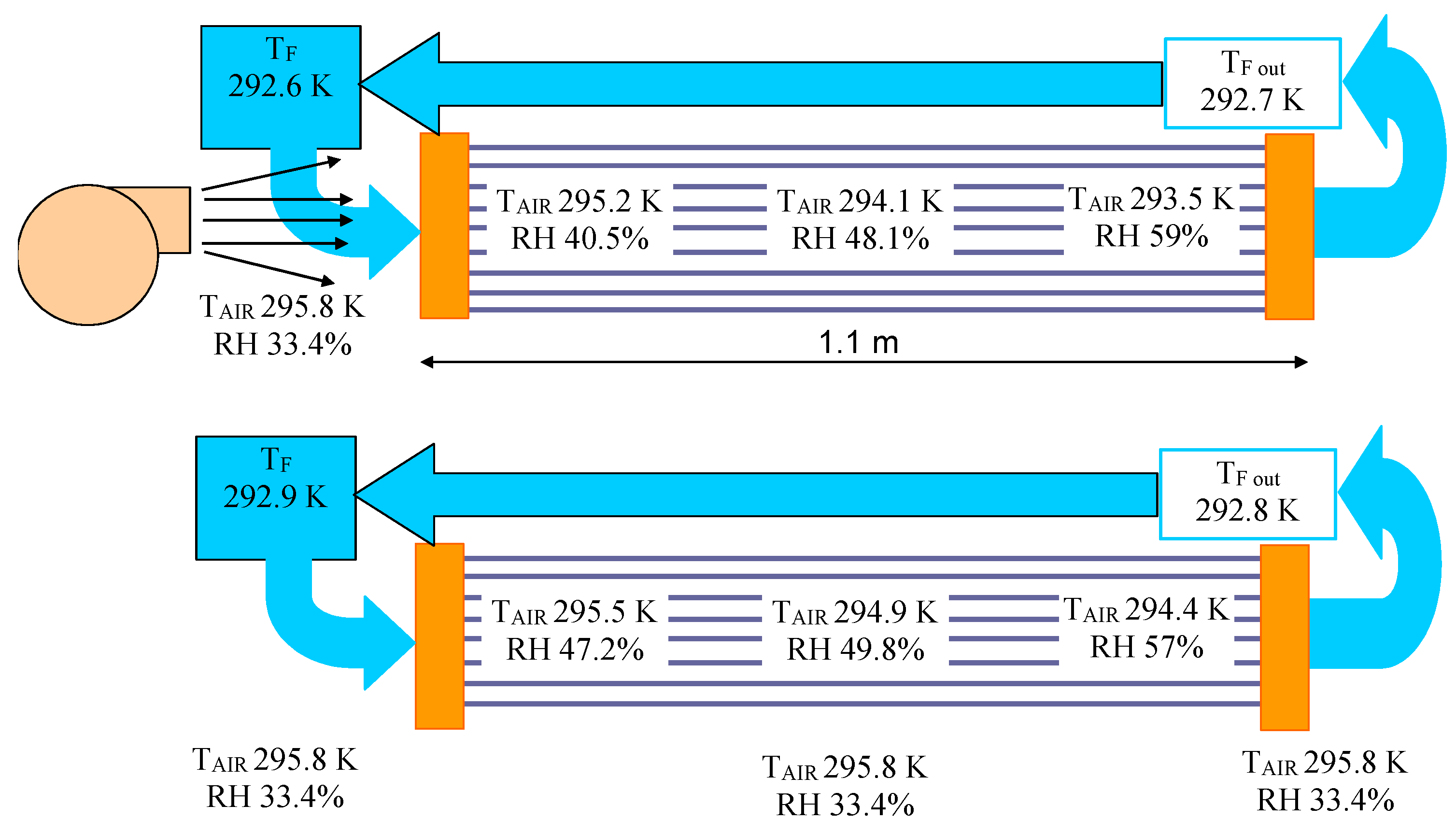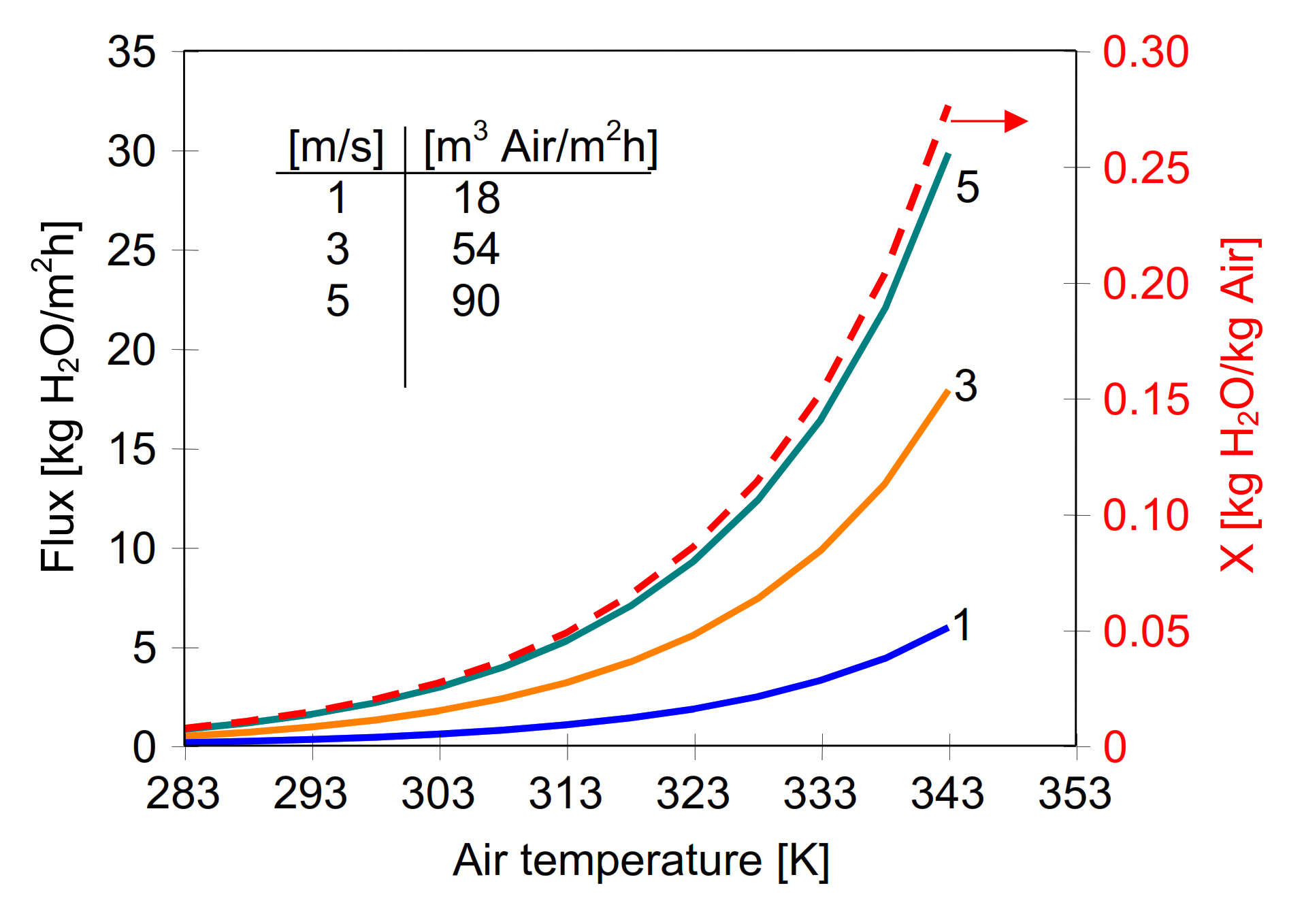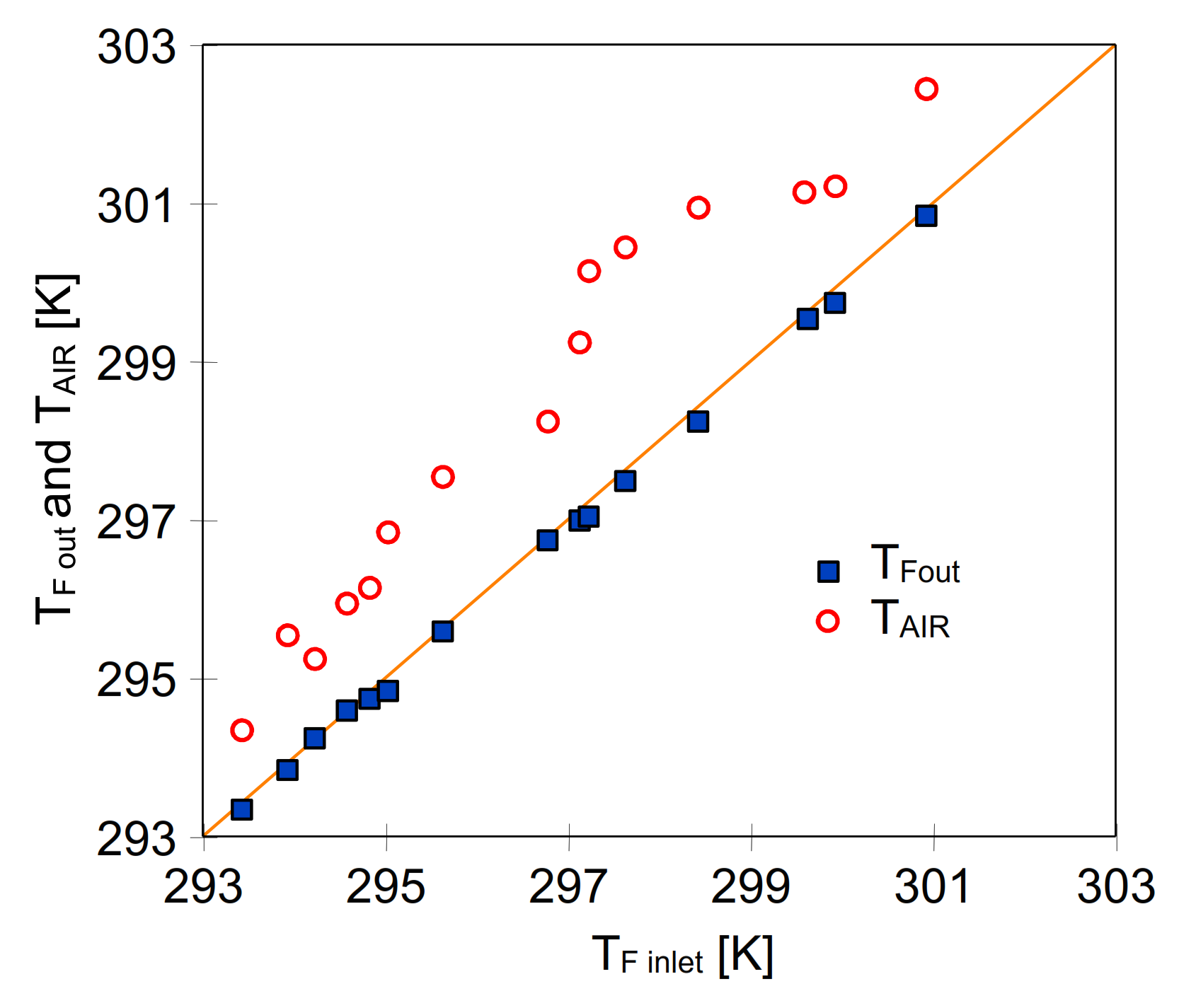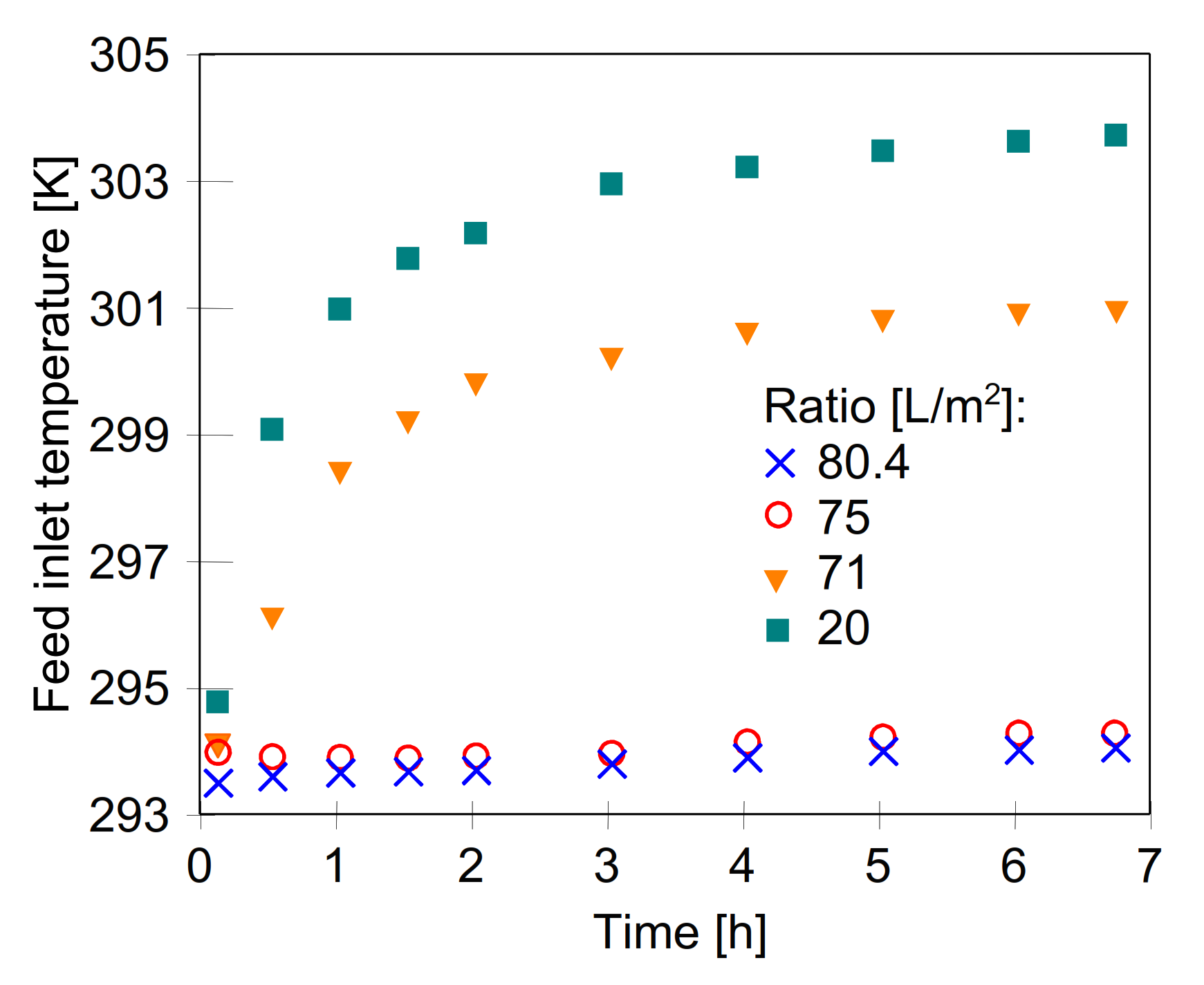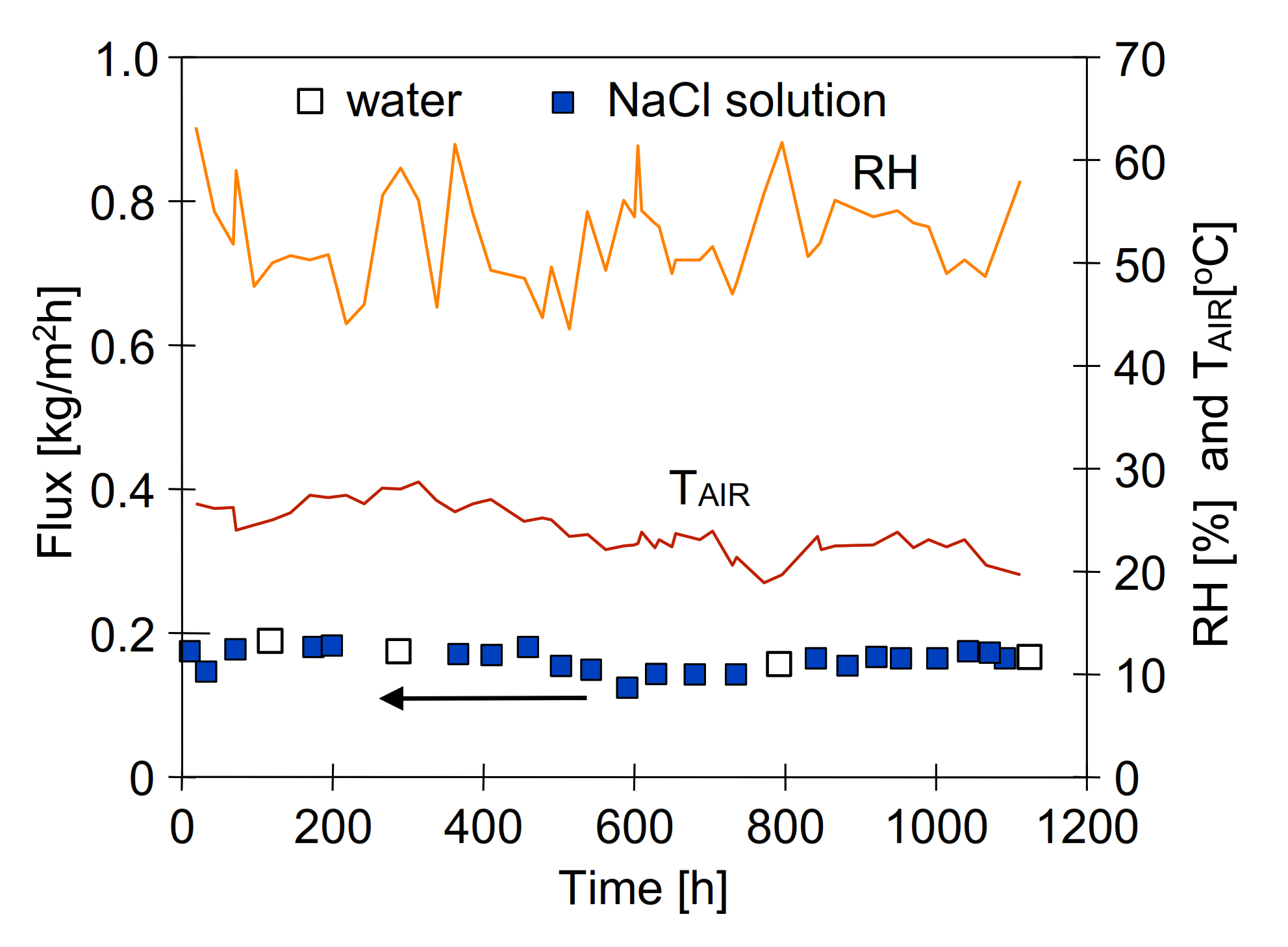1. Introduction
Membrane distillation (MD) is performed by phase change; therefore, this process is energy-consuming and over 2500 kJ/kg of permeate obtained is required [
1]. The water released from the feed in the form of vapour flows to the other side of the membrane where it is condensed, e.g., in the cold distillate stream. Such a case is called direct contact MD (DCMD) [
2,
3]. In the MD process, porous membranes made of hydrophobic polymers with a low thermal conductivity coefficient are used [
4,
5,
6]. However, due to the small thickness of the membranes (e.g., 100 µm), it does not eliminate the heat conduction from the feed to the permeate side and, as a result, heat losses in the DCMD process may exceed 50% [
2,
7]. This inconvenience was limited by separating the membrane from the cold distillate with a gas layer (Air Gap MD) [
8]. In another variant of the MD process, a gas stream flows on the permeate side [
1,
5]. A flowing gas is used to sweep the vapour out of the membrane permeate side, and this variant is called sweeping gas MD (SGMD) [
1,
3,
4,
5,
6]. The gaseous layer increases the resistance to heat transfer which decreases the heat loss by conduction. For this reason, the application of the SGMD variant allowed to reduce heat losses to the level of 20% [
9]. However, it must be recognised that in order to obtain freshwater from salt water in the SGMD variant, an external vapour condenser should be additionally used [
1,
10].
Water can also be desalinated by evaporating it from a wet surface of hydrophilic membranes. However, such evaporation caused a rapid crystallization of salts on the membrane surface [
11], hence, the hydrophilic membranes can be only used for the separation of feed without solutes. When the hydrophobic membranes are applied, as in the SGMD process, the evaporation of water proceeds at the feed/membrane interface and a cross-flow of non-saturated feed prevents the precipitation of solutes, even for a high concentrated brine [
12].
The driving force for mass transport in the MD process is the difference in vapour pressure [
2,
9]. In the case of SGMD, it results from the vapour pressure at the evaporation surface in the pores of the membrane and the water vapour content in the gas [
1,
5]. Mass and heat transfer causes both the concentration and temperature in the membrane adjacent layers to differ from those in the bulk (polarization effects), which reduces the driving force [
2,
5,
9]. It has been reported that increasing the turbulence flow of the stream usually allows to limit the influence of polarization phenomena [
10,
13,
14]. The polarization is particularly high on the side of the gas, which quickly becomes saturated with water vapour [
15]. However, in classic modules with high membrane packing density, increasing the gas flow velocity is limited due to a significant increase in flow resistance [
4]. To solve this problem, in the present work, an idea of open capillary modules was applied. In the modules, the water evaporation takes place from the surface of capillary membranes, whose bundles are loosely distributed inside large chambers. In such a system, the use of even high gas flow velocities do not cause a significant pressure drop. Apart from the flow velocity, the efficiency of the SGMD process is also influenced by the temperature of the feed and gas [
1,
4]. Increasing the feed temperature causes an exponential increase in the saturated vapour pressure, which leads to a significant increase in the driving force of mass transport [
15,
16]. As a result, the efficiency of the MD process increases, regardless of its variant [
17,
18,
19].
It must be stressed that, in the published articles, the presented assessment of the influence of the process parameters on the SGMD course differs many times. Indeed, increasing the feed flow velocity most often significantly increased the permeate flux [
10,
15,
17,
20]; however, in other studies, a slight influence of this parameter was shown [
14,
18]. The gas temperature at the inlet to the module usually has little effect on the process performance [
4,
15,
21], although its importance was shown in [
4]. The discrepancies in the presented results are generally due to the design of the membrane modules used and their size. For example, when the membranes surface is small, the evaporation of water does not cause a significant change in the temperature of the gas transported in large amounts, hence, the influence of the gas temperature on the SGMD efficiency can be observed [
21,
22]. In the case of using modules with a large membrane surface (e.g., 1–2 m
2), due to the mass and heat transport, the gas temperature quickly becomes close to the temperature of the feed and, as a result, this temperature affects the efficiency of the SGMD process [
4,
22].
The use of small SGMD modules for testing allows for very favourable yields, often above 20 L/m
2h [
15,
16,
18,
20]. Unfortunately, similarly to large DCMD modules, increasing the process scale causes a multiple decrease in the permeate flux [
4,
5,
6,
13,
23]. The amount of water vapour that the gas can absorb is small and increases with temperature, e.g., for air from 12.5 to 40.8 g/m
3 with a temperature change from 293 to 313 K. This means that for a temperature of 313 K, the evaporation of 10 kg/h of water requires the supply of air to the module in the amount over 245 m
3 (0.068 m
3/s). In the tested industrial modules, due to high flow resistance, the gas flows used were much smaller and, as a result, the gas quickly reached the saturation state, which significantly reduces the SGMD efficiency. For instance, in [
4], for the Celgard Liqui-Cel
® Extra-Flow module with an area of 1.4 m
2, the permeate flux of 0.5 L/m
2h was obtained. The efficiency at a level of 0.1 L/m
2h was obtained for a similar large module in work [
23]. In this case, this was due to the fact that the permeate flux was only calculated by measuring the difference in gas humidity at the inlet and outlet of the module. Meanwhile, during tests in the SGMD installation with a vapour condenser, it was repeatedly found that the amount of water sweep by the gas from the module was greater than that resulting from the change in gas humidity [
5,
17,
22]. This was explained in [
22,
23], where it was shown that after the gas is saturated, water vapour condenses and is removed from the module in the form of a mist. These observations were also confirmed in tests with the use of the industrial module [
4,
6].
A large evaporation surface can be obtained by using capillary modules [
1,
4,
23]. However, in this case it is difficult to maintain a uniform gas flow between the capillaries, especially for higher packing density of the membranes [
10,
24]. The conclusions from these works are similar to those obtained during tests of DCMD capillary modules, the efficiency of which increased significantly when the arrangement of capillaries ensured static mixing [
25]. The best conditions for mass transport in the MD module can be obtained by using cross-flow of the feed and permeate streams [
14], which was successfully applied in the construction of a small SGMD installation proposed for freshwater production in remote area [
1]. However, it can be expected that in large modules, e.g., with a capillary length of 1 m, the cross-flow of gas stream will cause the “sail effect”. This effect for higher gas flow velocities (e.g., 5 m/s) may, due to increased stresses, cause the capillaries to break at the point of their attachment to module head. For this reason, the design of SGMD modules should ensure low gas flow resistance for its high flow velocities [
4]. Such a possibility is given by the proposed open SGMD module design, where, additionally, flexible mounting of the capillary bundles can be used, which should limit the influence of the “sail effect”.
In the modules with shell, both the temperature of the streams and the feed concentration change along the module, which causes a decrease in the efficiency of the MD process [
15]. Uniformity of parameters along the entire surface of the capillary membranes was obtained in the MD process using submerged DCMD modules [
7]. Worthy of note, similar conditions can be achieved in the case of SGMD by using modules with membranes loosely placed inside large chambers with natural convection or forced air flow generated by fans. Due to the significant polarization on the gas side, the use of fans increasing the gas flow velocity should significantly increase the efficiency of the process [
15]. In the SGMD process, the use of the feed flow between capillaries is also possible. Indeed, it was carried out in the tests of 30 cm long module [
16]. However, in the case of longer modules, the pressure of the gas flowing inside capillaries will increase significantly, which may increase the costs of gas pumping [
4] and its bubbling through the pores of the membrane to the feed [
21]. Therefore, in the SGMD process, the feed flow is generally used inside the capillaries [
1,
4,
10,
23].
MD module efficiency is strongly affected by the capillaries distribution configurations and membrane packing density [
10,
24,
25]. In the proposed open capillary modules, the packing density of the membranes can be reduced, e.g., for membranes with a diameter of 2.6 mm spaced every 1 cm it would be 52 m
2/m
3. This value is several times lower than the value of 293 m
2/m
3 in Celgard Liqui-Cel
® Extra-Flow module, which did not allow to obtain good conditions for the SGMD process [
4]. The advantage of reducing the packing density is facilitated gas flow. Moreover, in a hot, sunny remote area, a large chamber with membranes could also function as a heat exchanger for air heating, which would significantly simplify the construction of the installation. In the presented work, the effectiveness of the SGMD process implemented in a capillary module without an external shell was tested. The aim of the research was to determine the influence of the process parameters on the level of real efficiencies of SGMD; hence, a module with a length similar to industrial modules was applied. Additionally, it was assessed whether, instead of feed pre-heating inside an external heat exchanger, it is possible to evaporate the water using only energy taken from the air flowing in the module.
Theory
The pores of the hydrophobic membranes applied in the SGMD process are non-wetted, and the feed evaporates from the feed/gas interface created inside the pores. The driving force for the water evaporation is created by a difference between the partial pressure of water vapour (in equilibrium with liquid feed), and its value in the air surrounding the membranes (
Figure 1). The obtained permeate flux is proportional to the driving force, which is usually expressed by the application of mass transfer coefficient (K
m) [
17,
22]:
where P
F and P
Air correspond to the saturated vapour pressure above the evaporation surface and the vapour pressure in the gas (air) stream, respectively.
The partial pressure of water vapour is strongly affected by the liquid temperature, and its value increases exponentially with increasing feed temperature, which can be expressed by the following equation [
26]:
where the units of T and P
F are °C and mmHg, respectively.
During the streams flowing inside the SGMD module, the value of driving force may change [
6,
15]. The water evaporation increases the solutes concentration in the feed (
Figure 1—C
m) which, in turn, decreases the P
F value. Moreover, the gas temperature and humidity fast increases, which strongly affects the SGMD module performance [
4,
26].
The vapour diffusion across the membrane pores creates the resistance for mas transfer [
27]. The Knudsen or molecular diffusion mechanism influences, in a different degree, on this resistance due to a pore size distribution and the process conditions (e.g., temperature level). Taking these parameters into account, the K
m coefficient is expressed in the form [
17,
18,
22]:
with the following parameters: porosity (ε), thickness (s), tortuosity (χ), molecular mass of water (M), gas constant (R), membrane temperature (T
m), and effective diffusion coefficient (D
WA). In the case of membrane with the pores below 0.1 μm the effective diffusion is dominated by the Knudsen diffusion [
6,
22].
In the case when the water is evaporated into the ambient air, a viscous boundary layer is formed above the evaporation surface through which the diffusion of water vapour takes places [
10]. The rate of liquid volume change evaporated from the wet surface under the isothermal conditions can be determined using Fick’s law [
11]:
where D is the diffusion coefficient of liquid particles in the air, A is the liquid surface area available for evaporation, δ is the thickness of viscous boundary layer, ρ is a density of liquid.
An important point which should be noted is that the thickness of the viscous boundary layer formed above the membrane surface can be reduced by increasing turbulence in the gas flow [
15]. However, this method cannot change the value of membrane thickness (s), which contributes to the value of δ (
Figure 1); hence, the thickness of the membrane has a significant effect on the SGMD process efficiency [
14]. Moreover, the value of P
Air is associated with air humidity, expressed e.g., by relative humidity (RH), thus, water evaporation increasing a value of the humidity also decreases the evaporation rate. For this reason, the process efficiency is limited in the modules with shell, because a value of the relative humidity of the air in the SGMD module rapidly increases even for high flow rates of air [
22,
27].
The maximal content of water vapour in air at given temperature is expressed by following equation [
10,
22]:
where P
S is water vapour pressure in saturated air and P
atm is atmospheric pressure.
Evaporation is an energy intensive process, therefore, the transport of heat to the interface is the rate-limiting step for the evaporation of liquids into an inert gas. Depending on the membrane installation design and process conditions, the temperature in the gas phase near the liquid–gas interface can be higher or lower than that of the liquid (
Figure 2). The application of feed temperature higher than the air temperature allows to increase the driving force of process, hence, pre-heating of feed (
Figure 2b) is usually realised in SGMD process [
4,
14,
15,
18]. In this case, the limitation is a small amount of water vapour that caused the saturation of the air, which can lead to unfavourable condensation of vapour inside the membrane module [
22,
26]. The vapour condensation on the membrane surface can be avoided when the modules without an external shell will be used, which also allows to curry out the evaporation without heating of the feed (natural evaporation). In this case, the bulk temperature of the air is higher than the temperature of the evaporating feed [
4,
15].
A temperature profile without feed heating is presented in
Figure 2a. The energy for evaporation (Q
V) can only be taken from the gas phase (Q
A); therefore, the water temperature is quickly aligned to the constant value due to a larger thermal conductivity and the temperature gradient in liquid is negligible. The heat transfer is described by the following equations [
9,
28]:
where ∆H
V is the latent heat of water vapour evaporation and h is the convective heat transfer coefficient (on the air side). When the feed is heated, a part of the feed energy is lost by conductivity (
Figure 2b, Q
C) into the air [
26]:
where H is the overall heat transfer coefficient.
The thermal efficiency (E) of MD process can be determined from the following relationship [
9]:
The value of convective heat transfer coefficient can be calculated from the Nusselt number estimated from following correlation [
28]:
where Nu is Nusselt number, Pe is the Peclet number, L—length of channel (e.g., membrane capillary), d
h—hydraulic diameter, λ—heat conductivity coefficient. The remaining model equations applied for calculation of submerged MD modules were presented in work [
7].
2. Materials and Methods
The studies of open capillary modules applied for SGMD were carried out using an installation presented in
Figure 3. During experiments with feed pre-heating the feed tank was immersed inside a water thermostat, which allowed to control the feed temperature.
The commercial hydrophobic K1800 polypropylene capillary membranes, manufactured for microfiltration (Euro-Sep, Warszawa, Poland), were used for the studies of membrane evaporation. A module was equipped with 16 capillary membranes, which were glued on both ends inside the PCV tube (1/2″ diameter). The capillary membranes have the internal diameter of 1.8 mm and outer diameter of 2.6 mm, and the effective length of 1.1 m. The total membranes area calculated for the lumen side amounted to 0.1 m2. The membranes were positioned rectangular in every third mesh of two polypropylene nets. A distance between each capillary membrane was about 1 cm. The obtained module packing fractions was 0.05 and membrane packing density 52 m2/m3.
In [
1], a horizontal arrangement of capillary membranes was proposed, which is possible in the case of short capillaries. Filling long horizontal capillaries with water would cause their significant deflection and stress in the places of their attachment, which would increase the risk of capillary breakage. For this reason, in the modules used, the capillaries were mounted vertically, with flexible mounting of the lower head of the module, as schematically shown in
Figure 3. This solution enables a capillary bundle wave, which allows eliminating the negative influence of the “sail effect”, which may be important for higher gas flow velocities through the chamber.
In this work, most of the tests were carried out in a room with air circulation caused by the ventilation system, which, for the required multiple air changes per hour, assured the air flow in the range of 0.002–0.005 m/s. Tests were also carried out with air forced by the fan from the bottom to the top of the capillaries. In this case, the gas flow velocity in the lower part of the module was 2.3–2.5 m/s and along the module it decreased to 1.8 m/s in the upper part. The fan did not have rotor speed control, hence, the obtained air flows resulted from the factory efficiency of the fan. Whereas the fan was equipped with an electrical heat element, which made it possible to additionally carry out tests with hot air (313 K). The air flow velocity was measured using electronic anemometer MT-881 (MeasureMe, China).
The feed flowed inside the capillaries (lumen side) during the evaporation experiments. A peristaltic pump was used, and the feed flow rate was equal to 0.1 m/s. The influence of flow velocity (0.1–0.59 m/s) on the evaporation efficiency was additionally investigated.
The total dissolved solids (TDS) of solutions were measured with a 6P Ultrameter (Myron L Company, Carlsbad, CA, USA). This meter was calibrated for measurements as NaCl using TDS/conductivity standard solution (Myron L Company). The air temperature and relative humidity were measured by electronic hygrometer AZ8829 (AZ-Instruments, Kraków, Poland) connected with computer software TRLOG v. 3.4. The feed temperature was measured using electronic thermometers PT-401 with measurement accuracy 0.1 K (Elmetron, Zabrze, Poland).
The membrane evaporation tests were carried out using distilled water or NaCl solutions (pure NaCl, Chempur, Piekary Śląskie, Poland) as a feed. The studies was conducted continuously for several months. Indeed, the experiments started in June (summer) and ended in October (autumn). The changes of module efficiency (maximum permeate flux) were measured periodically at established periods using distilled water as a feed. The MD installation was working continuously. The permeate flux was calculated every 20–24 h, based on the decrease of the feed volume.
